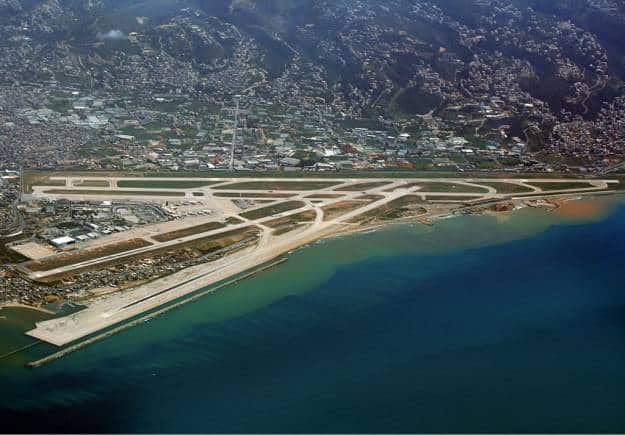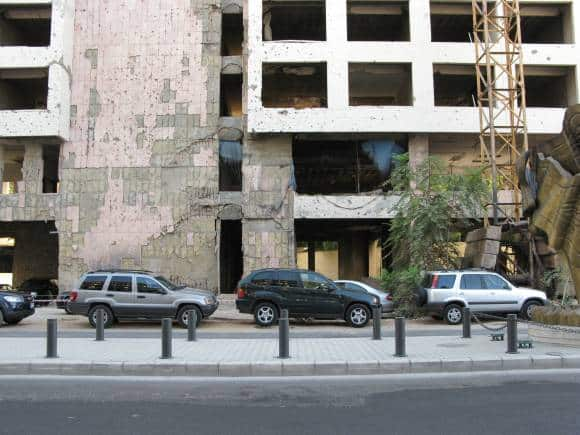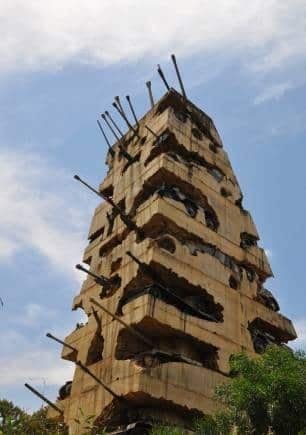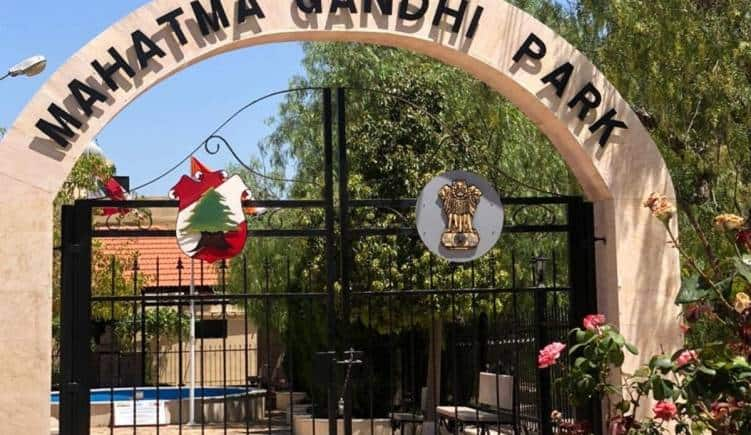



In 2006, I landed a week-long assignment in Beirut. Operating out of Paris and working part time for a French NGO, the assignment had come to me by sheer accident. A Colombian national who had departed for the assignment, had been refused passage. I wasn’t quite sure why, but it seemed clear that travel to Beirut posed some challenges. One of which became obvious when I appeared for my visa interview, if you had travelled to Israel, the Lebanese didn’t entertain you and if you had the Lebanese visa in your passport, you could not enter Israel. Passport pages are one place that global geopolitics leaves its imprints.
The visa interview was brief and ended with a stamped visa. I was on an inspection towards the end of construction works of a fairly large and important Centre for Orthopaedic Rehabilitation financed by Lyon headquartered Handicap International, their Lebanese NGO partner, Arc-en-ciel (French for rainbow) was going to host me and French was to be the language of interaction. I had never thought of travel to Beirut and had very little clue of what to expect, but now that I was travelling, I felt a certain excitement.
The view outside the window, as we descended into the Beirut airspace, was stunning — just a sliver of rocks separating the long airstrip from an endless azure blue Mediterranean sea and Beirut climbing up the hills on the other side.
 Beirut’s airport kissing the Mediterranean Sea. (Photo: Ian Lim, GNU, Creative Commons)
Beirut’s airport kissing the Mediterranean Sea. (Photo: Ian Lim, GNU, Creative Commons)Immigration was smooth, and as I stepped out, I was greeted by the warm Arc-en-ciel team. We went into meetings almost immediately, there was a lot to cover and time was short. While Beirut was beautiful, past signs of war and unrest were quite visible, my hotel room looked upon an abandoned high-rise, pock marked with bullet and artillery shell holes with balconies blacked out. Many occupied buildings also had similar signs. Virtually all city squares had an army tanker with security deployment.
 Remains of Lebanese Civil War, damaged buildings in central Beirut, Holiday Inn. After the fighting ceased, the building became a popular site for underground dance parties. (Photo: Vyacheslav Argenber, Creative Commons)
Remains of Lebanese Civil War, damaged buildings in central Beirut, Holiday Inn. After the fighting ceased, the building became a popular site for underground dance parties. (Photo: Vyacheslav Argenber, Creative Commons)The work site was at some distance, at Taanayel in the picturesque Bekaa valley. While we drove to Taanayel we crossed a mountain pass which had one of the more sobering sights, a bombarded-out building with military tanks and the guns sticking out. Located next to the Ministry of National Defence, called “Hope for Peace Monument”, it was designed by French-born American artist, Arman Fernandez, containing 78 military vehicles from a range of eras and nations it was built to commemorate the end of the Lebanese civil war in 1990. We stopped and I got off to take a closer look and some photos to notice the monument was fenced off by barbed wire and be waved off by annoyed security personnel, the “Hope for Peace Monument” was off limits.
 The ‘Hope for Peace’ monument is 32 metres high and contains 78 tanks and vehicles. (Photo: Lolinka, Creative Commons)
The ‘Hope for Peace’ monument is 32 metres high and contains 78 tanks and vehicles. (Photo: Lolinka, Creative Commons)The days were spent visiting site, meeting the teams including the Beirut based architects. The building I had come to inspect was beautifully designed and built and was good to occupy. I could visualise how this centre would provide much needed world-class facilities to the Bekaa valley, which unfortunately suffered from the past and ongoing conflict and large refugee inflow.
The hosts were warm, there was an amazing energy, I had many sobering conversations. I visited Arc-en-ciel’s disability aids manufacturing unit, manned entirely by high spirited, fun and able-bodied men, in the prime of their lives. Some disabled while in combat, others victims of combat. It didn’t matter anymore on whose side they fought or whom they had supported, they were all there to help build a disability inclusive Lebanon. And to top it they had a crack wheelchair basketball team.
My visit dates were such that I had a day off to match a local holiday. I decided to explore the city, identified a route, took my camera and travel documents and set out on foot. The city was rather quiet, thanks to the local holiday. The omnipresent security infrastructure with machine gun wielding, uniformed men with tankers guarding most squares coupled with empty streets made me feel a bit eerie, there was also a nip in the air. I realised that I hadn’t taken a single picture, I felt as if every move was being watched though in reality the guys were most certainly just plain bored. I decided to head back.
As I returned, I noticed a small road side ice-cream shop manned by a senior gent. I stopped and requested for an ice-cream. He had only one flavour, a kind of milk ice cream. As he served me my cup, he asked me if I was Bangladeshi. I replied that I was Indian. Maybe my response wasn’t very clear to him, he continued saying that he knew Bangladeshis well, number of Bangladeshis had served under him at the ship building facility he headed. They were very dissatisfied with the food, they needed rice. He wanted a happy workforce and organised rice for them. “They had mountains of rice!” He made big mounds with his hands and smiled. He was a retired senior officer of the Lebanese Navy and was overseeing naval ship building at that time he added. This soft-spoken diminutive gentleman, dressed very simply in a white cotton T-shirt, pants and slip on shoes, gently selling ice cream from a small road-side shop seemed far away from the pressures and intrigues of war, even more so in the context of Lebanon. I still wasn’t sure if he had caught that I was Indian, so I said something to the effect that certain regions in India also consume large quantities of rice.
 Entrance to the The Mahatma Gandhi Park in Ebl-es-Saqi in south Lebanon. (Photo: unifil.unmissions.org)
Entrance to the The Mahatma Gandhi Park in Ebl-es-Saqi in south Lebanon. (Photo: unifil.unmissions.org)He seemed to catch it this time and asked, “If you are Indian … have you read Gandhi?”, I was taken aback, I mumbled that I had read his autobiography. He repeated his question and without waiting for my response continued, telling me that he had trained at the elite United States Military Academy West Point. He took a piece of paper from his shop desk and told me, “Let me explain the three military strategies I was taught at West Point”. I was really intrigued, and I watched as I scooped my ice cream. Starting to draw he explained, “The first one is the American, they have the numbers, the largest and best equipment, and their strategy is to flaunt it. The American forces will come out in all the finery, an exhibition of their fire power and approach their enemy using a direct and visible path, they will ensure that the enemy sees what they are getting into, they want to overwhelm the adversary into submission with their sheer might.” He had drawn what seemed like two parallel lines, he continued, “But, as we have seen time and again this strategy does not always work. Also, the Americans cannot take too many casualties of their personnel and the war effort comes under a lot of pressure from back home”.
Looking at me to check if I was still following, he continued, “The second strategy is that of the guerilla — it is the exact antithesis of the American” he put pen back to paper. “They know that they will never match the weaponry and numbers of their enemy. They don’t expose themselves at all, they are the kings of the terrain, invisible, they launch surprise bloody attacks, they disappear just as quickly. They disorient and demoralise their enemies, put them at their wits end and put in them a mortal fear. They can work with very little and inflict bloodied damage and have been effective in stalling and at times even forcing a retreat”. He took a long pause, the drawing was full of stops and turns and arrows from front and back, a chaos.
 A file photo of Sanjiv Arora (left), former Ambassador of India to Lebanon, after paying homage to India's Father of the Nation at the Mahatma Gandhi Park in Ebl-es-Saqi in south Lebanon. (Photo: Twitter)
A file photo of Sanjiv Arora (left), former Ambassador of India to Lebanon, after paying homage to India's Father of the Nation at the Mahatma Gandhi Park in Ebl-es-Saqi in south Lebanon. (Photo: Twitter)He started to draw again, “The third strategy is that of Gandhi. Gandhi wanted freedom and anything short of it was not acceptable, and he announced it loud and clear. In public view, clearly visible to his adversary and to the world at large, including the Indian masses, he started his movement for freedom. If he took the path of violence the movement would be brutally crushed. But how can you attack a peaceful protest, you cannot open fire on unarmed people so easily, how do you justify your violence against non-violence, where will your claim of a superior civilisation stand, what credibility will be left of you. The British, of course, used violence, but every time they did, they lost a bit more. People saw the brutality of the regime, it triggered more people to join, the world watched and questioned and were inspired. The movement grew in stature the demand for freedom grew more legitimate. It was a long walk, but it got to its destination eventually, Gandhi won the war.” He paused — the third drawing resembled a long meandering river.
 Stamp issued by Lebanon on the occasion of the 150th birth anniversary of Mahatma Gandhi.
Stamp issued by Lebanon on the occasion of the 150th birth anniversary of Mahatma Gandhi.I had finished my ice cream. I was left without words, I didn’t want to make some awkward banter. I counted out my dirhams, I had the exact change and handed over the money for the ice cream. I thanked him and requested if I could guard the drawing, he folded the A4 sheet and gave it to me. He was smiling, as I left he said, “One should read Gandhi, really read Gandhi.”
I regret that while I did keep that drawing carefully for quite some time, it got discarded at some point.
Discover the latest Business News, Sensex, and Nifty updates. Obtain Personal Finance insights, tax queries, and expert opinions on Moneycontrol or download the Moneycontrol App to stay updated!
Find the best of Al News in one place, specially curated for you every weekend.
Stay on top of the latest tech trends and biggest startup news.